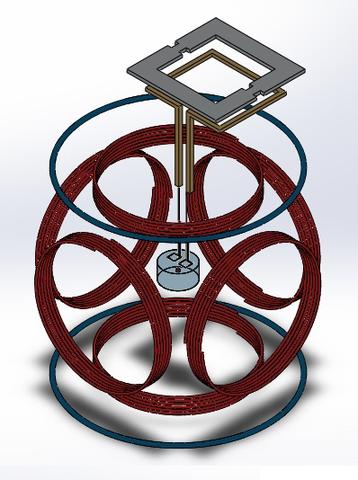Summary
We are developing a method to measure and regulate temperature throughout a three dimensional volume with Systeme International (SI)-traceable Thermal Magnetic Imaging and Control. Thermal MagIC will provide microscale spatial resolution and 25 mK accuracy within measurement times of 0.1 s in optically hidden volumes of solid composites, complex fluids, and biological systems.
Description

Temperature affects every physical system, every chemical reaction, and every biological process. Although imaging within materials and living things with X-rays and magnetic resonance is now routine, no general method to measure and regulate temperature throughout a 3D volume currently exists.
We are developing just such a method for Systeme International (SI)-traceable Thermal Magnetic Imaging and Control (Thermal MagIC) which will provide microscale spatial resolution and 25 mK accuracy within measurement times of 0.1 s in optically hidden volumes of solid composites, complex fluids, and biological systems. The method comprises three elements: magnetic nano-objects (MNOs) with high thermal sensitivity from 200 K to 400 K, a spatially-selective magnetic drive and sensing instrument, and a technique for traceable extraction of temperature from the magnetic response of the MNOs. Thermal MagIC will enable accurate, 3D measurement and control of temperature for research and development, as well as manufacturing and quality control, anywhere temperature plays a critical role.
When successful, NIST will have localized and remote temperature measurement and control system based on
- Magnetic nanoparticle (MNP) thermostats
- Near room temperature
- Remote
- Non-optical
- Microscale spatial resolution
- 25 mK temperature resolution
- Improved fundamental measurement science and understanding of interfaces
- Broad impact across diverse fields in industry, including automotive, electronics, chem/bio engineering, medicine
Major Accomplishments
Nanothermometers
We have developed three distinct classes of nanothermometers, which use different routes to achieve temperature-range tunability:
- composition (doped-cobalt ferrite [250 K to 350 K], NiPt and CoPt alloys [250K to >400K]) to control Curie temperature or coercivity;
- core/shell structure (ferrite core with cobalt oxide shell [200 K to 340 K]) to control exchange interactions;
- size (ferrite chains [270 K – 330 K] to control dipolar interactions and therefore magnetic anisotropy.
Instrumentation for Nanothermometer Characterization
We have developed or are developing four different types of AC magnetometry instruments for characterization of MNO nanothermometers, including:
- temperature-tunable magnetic particle spectrometer (T-MPS)
- temperature-tunable AC susceptometer (ACS)/magneto-relaxometer (MRX) (1 kHz to 50 MHz / 20 ns – 1 ms)
- temperature- and magnetic field- tunable AC susceptometer (DC to 10 MHz)
- high-frequency AC magnetometer (HFAC)
Micromagnetic Simulations of MNO Nanothermometers
We issued two new releases of NIST’s micromagnetic software (OOMMF), and enhanced OOMMF with the ability to model anti-ferromagnetism (AFM), added support for property variation during simulation (e.g., as a function of temperature or field), and improved inter-process communication for hundreds of simultaneous jobs. We also performed the first-ever stability analysis for the micromagnetic AFM model, which uncovered issues in certain parameter regimes.
Instrumentation for Temperature Magnetic Particle Imaging (T-MPI)
We have designed and constructed a temperature-tunable T-MPI scanner, in conjunction with rigorous simulation and reconstruction analysis (see below).
Simulations of Instrumentation
We have developed in-house MPI/MPS data simulation software to include effects such as non-linear magnetic gradient fields, non-uniform magnetic drive fields, space-dependent coil sensitivity, temperature gradients and particle relaxation.
Image Reconstruction for T-MPI
We have developed in-house robust methods to reconstruct image data from the raw signals of the T-MPI. This has enabled us to perform the first estimation of uncertainty of reconstructed data as well as analyze the harmonic dependence of the MPI signal. These in-house methods have been optimized for GPU-accelerated parallel processing to speed up execution times by at least an order of magnitude.

